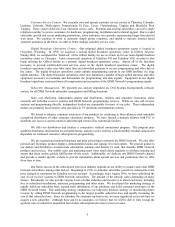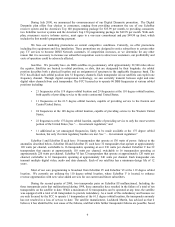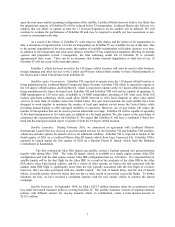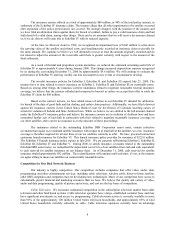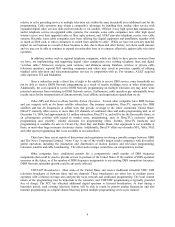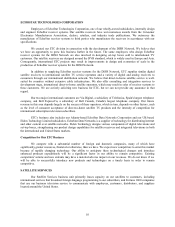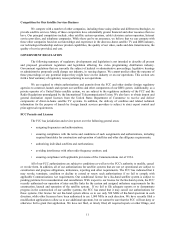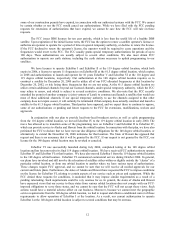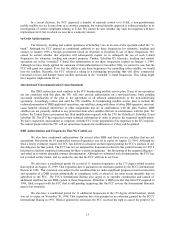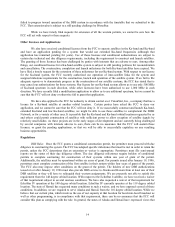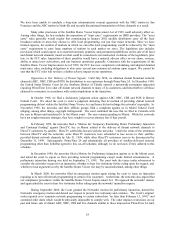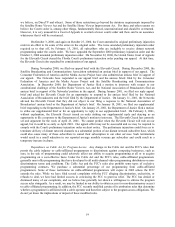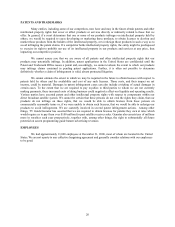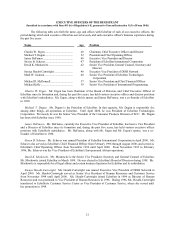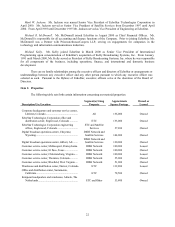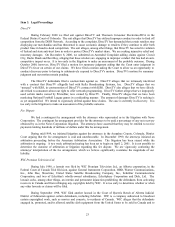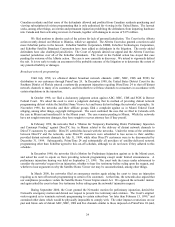Dish Network 2000 Annual Report Download - page 17
Download and view the complete annual report
Please find page 17 of the 2000 Dish Network annual report below. You can navigate through the pages in the report by either clicking on the pages listed below, or by using the keyword search tool below to find specific information within the annual report.15
our service to these states from various orbital locations does not comply with our FCC imposed obligations to serve
those states, and we cannot be sure that the FCC will not accept these views.
Subject to applicable regulations governing non-DBS operations, a licensee may make unrestricted use of
its assigned frequencies for non-DBS purposes during the first five years of the ten-year license term. After the first
five years, the licensee may continue to provide non-DBS service as long as at it dedicates at least one-half of its
total capacity at a given orbital location to providing DBS service. Further, the FCC indicated its desire to streamline
and revise its rules governing DBS satellites. We cannot be sure about the content and effect any new DBS rules
might have on our business.
Certain Other Communications Act Provisions. As a distributor of television programming, we are also
affected by numerous laws and regulations, including the Communications Act.
The FCC imposes different rules for “subscription” and “broadcast” services. We believe that because we
offer a subscription programming service, we are not subject to many of the regulatory obligations imposed upon
broadcast licensees. However, we cannot be certain whether the FCC will find in the future that we should comply
with regulatory obligations as a broadcast licensee with respect to our current and future operations, and certain
parties have requested that we be treated as a broadcaster. If the FCC determined that we are a broadcast licensee,
the FCC may require us to comply with all regulatory obligations imposed upon broadcast licensees, which are
generally subject to more burdensome regulation than subscription service providers like us.
Under a requirement of the Cable Act, the FCC imposed public interest requirements on direct broadcast
satellite licensees, such as us, to set aside four percent of channel capacity exclusively for noncommercial
programming for which we must charge programmers below-cost rates and for which we may not impose additional
charges on subscribers. This could also displace programming for which we could earn commercial rates and could
adversely affect our financial results. The FCC has not reviewed our methodology for computing the channel
capacity we must set aside or for determining the rates that we charge public interest programmers, and we cannot
be sure that, if the FCC were to review these methodologies, it would find them in compliance with the public
interest requirements.
Under a requirement of the Telecommunications Act of 1996, the FCC recently imposed upon broadcasters
and certain multichannel video programming distributors, including us, the responsibility of providing video
description for visually impaired persons. Video description involves the insertion into a television program of
narrated descriptions of settings and actions that are not otherwise reflected in the dialogue, and is typically provided
through the Secondary Audio Programming (SAP) channel. Commencing April 12, 2002, affected multichannel
video programming distributors like us will be required to provide video description for a minimum of 50 hours per
calendar quarter (roughly four hours per week) of prime time and/or children’s programming on each of any of the
top five national non-broadcast networks they carry. In addition, distributors will be required to “pass through” any
video description they receive from a broadcast station or non-broadcast network if the multichannel video
programming distributor has the technical capability necessary to do so associated with the channel on which it
distributes the programming with video description. While the FCC acknowledged that programming networks, and
not multichannel video programming distributors, may actually describe the programming, it declared that for ease
of enforcement and monitoring compliance it would hold distributors responsible for compliance. We cannot be sure
that these requirements will not impose an excessive burden on us.
The FCC has commenced a rulemaking which seeks to streamline and revise its rules governing direct
broadcast satellite operators. This rulemaking concerns many new possible direct broadcast satellite rules. There can
be no assurance about the content and effect of any new direct broadcast satellite rules passed by the FCC, and the
new rules may include expanded geographic service requirements for Alaska, Hawaii and Puerto Rico. The FCC has
also recently released a notice of proposed rulemaking regarding the current restrictions on the flexibility of DBS
companies to provide services other than DBS, and may change these restrictions.
Certain Other Rulemakings. The FCC recently proposed to allocate additional “expansion” spectrum for
DBS operators starting in 2007. DirecTV has filed an application for a satellite system using those expansion
frequencies.


